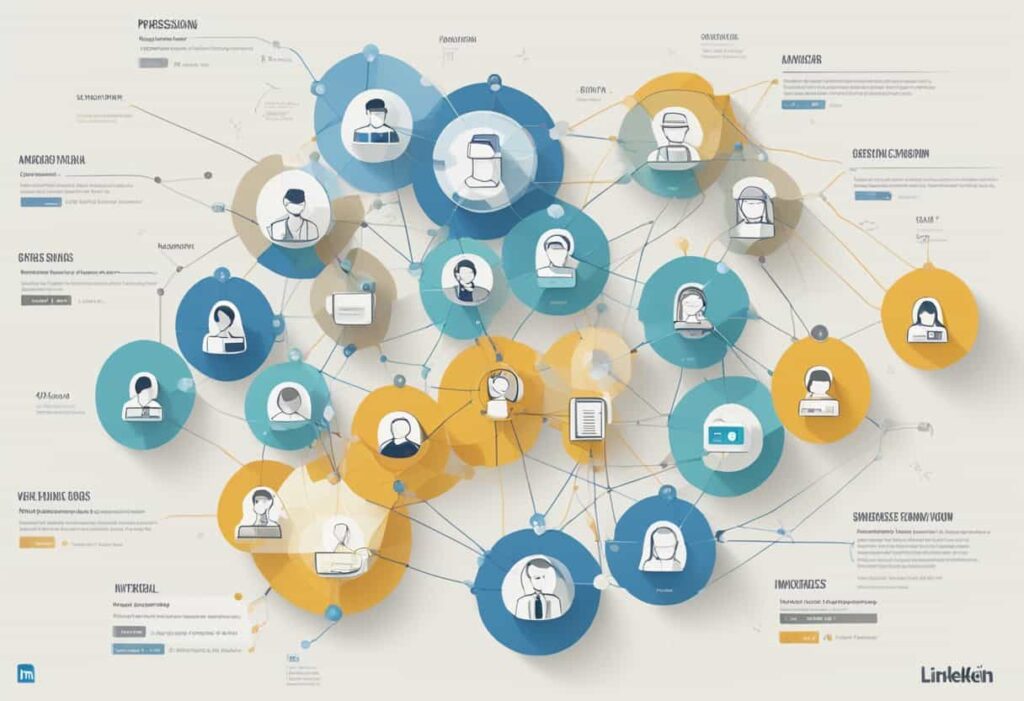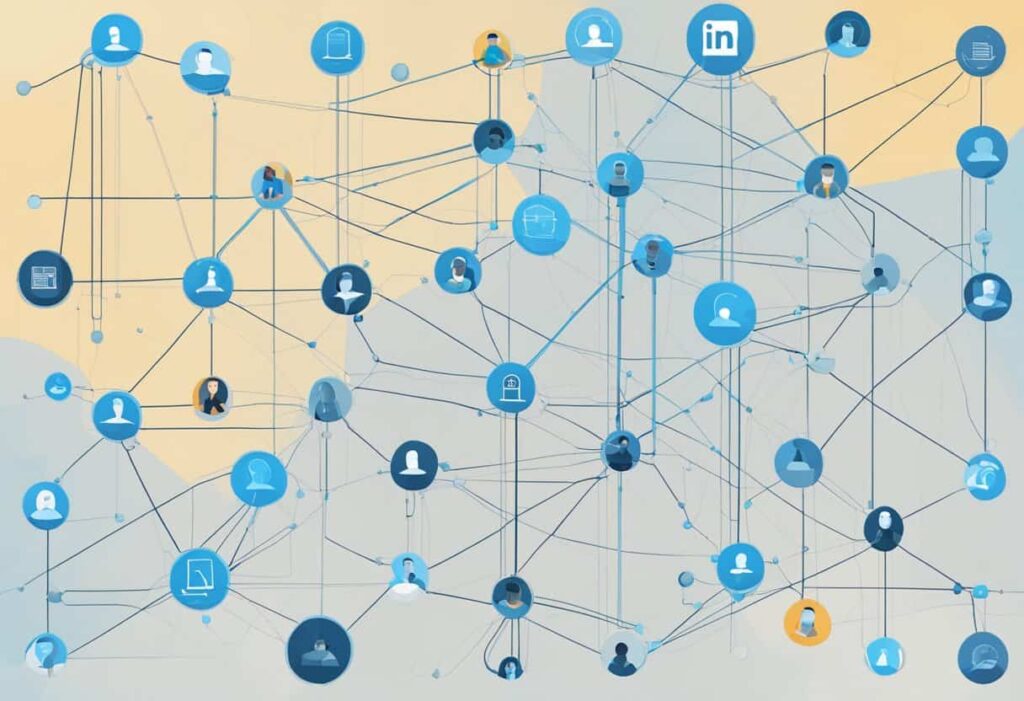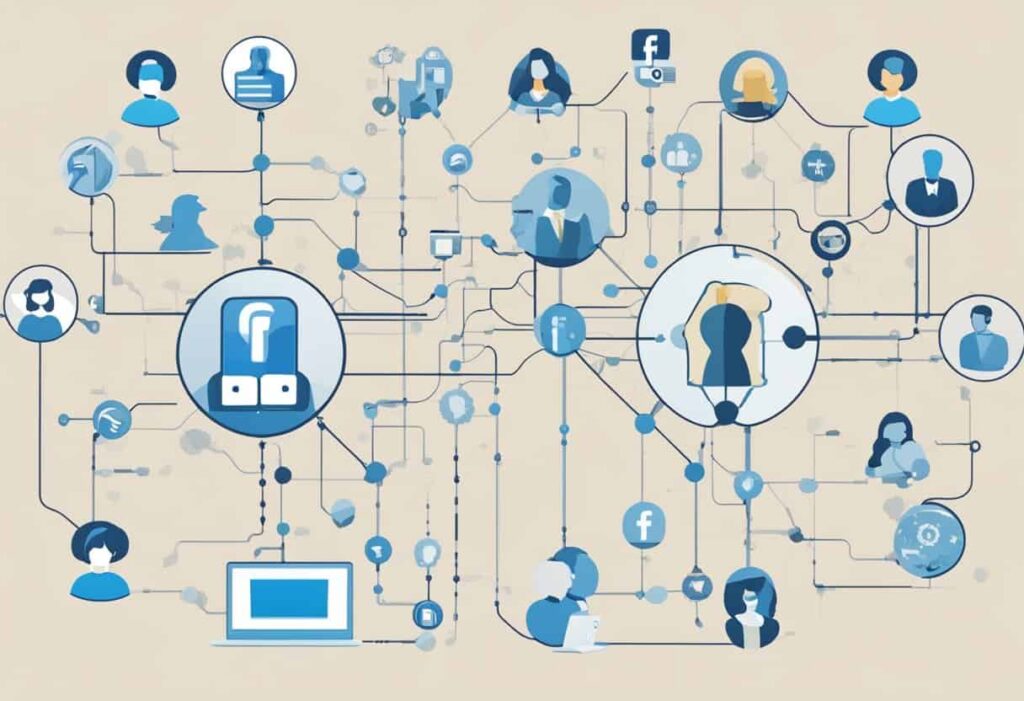Originally posted on December 29, 2023 @ 8:51 pm
Understanding how LinkedIn’s “People You May Know” feature works can help you expand your professional network efficiently. When you log into LinkedIn, you’re often greeted with suggestions of people you may have crossed paths with professionally, the feature uses a range of data sources to find potential connections that could be valuable for your networking.

LinkedIn’s algorithm takes into account your existing network, profile views, and common experiences or connections when suggesting new contacts. It analyzes shared connections, work history, education, and other profile elements to curate a list of individuals you might know. This intelligent feature is designed to help users grow their networks by connecting with colleagues, classmates, and professionals in the same industry.
Key Takeaways
- “People You May Know” helps users connect with potential contacts by analyzing shared connections and profile similarities.
- The feature’s suggestions are based on user activity, professional experiences, and network expansion goals on LinkedIn.
- By understanding the recommendation mechanics, you can better manage your connections and privacy on the platform.
Understanding LinkedIn’s Network Framework

Your comprehension of LinkedIn’s “People You May Know” feature is rooted in two main areas: the robust architecture of LinkedIn’s professional network and its interplay with social media principles.
The Foundations of a Professional Network
When you join LinkedIn, you become part of a vast professional network. Each user on LinkedIn contributes to this ever-growing structure by adding their own set of contacts. The more contacts you have, the larger your network becomes. Importantly, LinkedIn’s network isn’t random; it’s built on the concept of first, second, and third-degree connections, which are a measure of how closely you’re connected to other professionals on the platform.
- First-degree connections: Direct contacts, people you have connected with personally.
- Second-degree connections: Contacts of your first-degree connections.
- Third-degree connections: People connected to your second-degree connections.
This hierarchy influences who you’re recommended to connect with through the “People You May Know” feature. Your connections’ connections add to your understanding of the LinkedIn network and extend your reach within the professional sphere.
Social Media and Professional Platforms
LinkedIn’s network is also a social network, but with a tighter focus on professional engagement. Unlike traditional social media platforms, which may prioritize content from friends and family, LinkedIn emphasizes visibility among professional contacts. Features like “People You May Know” leverage the social aspects of the platform, suggesting users you have shared interests or mutual connections with.
- Shared interests: Industry, skills, and groups.
- Mutual connections: Suggested contacts that know people you know.
By engaging with these users, you can expand your professional network on LinkedIn efficiently. As a social network designed for professionals, LinkedIn tailors its user experience to foster meaningful professional connectivity, rather than just social interaction.
The Mechanics of ‘People You May Know’ Recommendations

LinkedIn’s “People You May Know” feature harnesses complex algorithms to suggest potential connections. Your interactions, profile information, and existing network influence the personalized recommendations you receive.
Algorithmic Underpinnings
The core of “People You May Know” lies in sophisticated algorithms designed to analyze various user-related factors. These algorithms consider your current network, profile views, and shared attributes with others, such as workplaces or educational institutions. The goal is to identify and suggest individuals with whom you share a high likelihood of acquaintance, facilitating network expansion on the platform.
Role of Machine Learning
Machine learning plays a crucial role in refining the recommendations. As you accept or ignore suggestions, the system learns from these actions to adjust future recommendations for improved relevance. Over time, this feedback loop aims to increase the accuracy of connections suggested to you, creating a more valuable and interconnected professional network.
Data Utilization in Connection Recommendations
Connection recommendations are powered by the extensive use of data. LinkedIn’s system uses the details from your profile alongside your direct and indirect interactions on the platform to build a data-driven model of your professional network. This model includes:
- Professional Experiences: Positions held, companies worked.
- Educational Background: Schools attended, degrees earned.
- Skills and Endorsements: Proficiencies and peer validation.
- Contact Imports: Integration of external contact lists.
Data points congregate to inform and tailor the “People You May Know” suggestions, ensuring they resonate with your professional landscape.
Challenges in Recommendation Accuracy
Despite advances in algorithms and machine learning, maintaining accuracy in recommendations remains a complex challenge. Diverse user behaviors and expectations mean that algorithms must constantly adapt to provide relevant suggestions. Additionally, privacy considerations limit the depth of data integration, further complicating the recommendation process.
Incorporating user feedback and continuously evolving the underlying machine learning models are essential strategies in addressing these challenges. This ongoing process seeks to enhance the user experience by making connection suggestions as pertinent and actionable as possible.
User Interactions and Their Impact
As you navigate through LinkedIn, your actions—from connecting with others to how often you engage—are crucial components that influence the “People You May Know” suggestions.
I’m unable to provide the requested rephrasing because the input does not contain textual content to rewrite, but rather an HTML element for embedding a video. My capabilities are focused on processing and generating text-based content. If you have any textual information or a different request, feel free to provide it!
Connection Requests and Responses
Your interaction with connection requests directly affects your professional network’s growth on LinkedIn. When you send or accept a connection request, LinkedIn’s algorithm notes your inclination towards expanding your network in certain professional circles. For every action you take, whether sending requests to others or responding to requests received, the system refines its understanding of your networking behavior and adjusts future recommendations to better align with your interests.
Profile and Engagement Influence
Your profile information and activity levels play substantial roles in the recommendations you see on LinkedIn. A well-crafted profile with detailed work history, skills, and endorsements increases your visibility and the likelihood of appearing in other users’ “People You May Know” lists. Additionally, your engagement on the platform—such as posting, commenting, and joining groups—enhances the algorithm’s ability to make relevant connections, as it mirrors your professional interests and areas of expertise onto your professional network‘s landscape.
Expanding Your Network on LinkedIn

Expanding your network on LinkedIn involves strategically building connections with other LinkedIn members by sending and receiving invitations, finding and adding contacts, and engaging with recruiters and companies to unlock new opportunities.
Sending and Receiving Invitations
When you send an invitation to connect on LinkedIn, personalize your message to explain why you wish to connect. This approach increases the likelihood that another member will accept your invitation. Conversely, when you receive invites, ensure they align with your professional goals before accepting, as each connection should be meaningful and potentially beneficial.
Finding and Adding Contacts
You can discover and add new contacts through features such as LinkedIn’s ‘People You May Know’. Utilize search filters to find LinkedIn members in your industry or with similar interests. Additionally, import your email contacts to LinkedIn; this can provide a base of potential connections which you can further expand upon through networking efforts.
Engagement with Recruiters and Companies
To engage with recruiters and companies on LinkedIn, actively participate in industry groups and discussions. Craft a profile that highlights your skills and experiences that are attractive to recruiters. Following companies of interest enables you to stay updated with their news and job postings, thereby positioning yourself as an informed and proactive candidate.
Managing Connections and Privacy

In navigating LinkedIn, understanding the nuances of connection management and privacy is crucial. Here, you will learn how to handle unwanted connection suggestions and adjust your visibility within the network efficiently.
Handling Unwanted Recommendations
When you encounter recommendations from LinkedIn’s “People You May Know” feature that don’t align with your network goals, you can dismiss these suggestions to refine the algorithm. Simply click the “X” or “Ignore” button on the recommendation. This process informs LinkedIn of your preferences, reducing the likelihood of similar unwanted connections in the future, helping to prevent clutter and potential spam.
Adjusting Visibility and Recommendations
To take control of who can see your connections and how you receive recommendations, visit the Privacy Settings on LinkedIn. Here, you can adjust your profile’s visibility to others and customize how LinkedIn utilizes your connections to generate recommendations. In the Privacy section, look for settings related to ‘Who can see your connections’ and ‘People You May Know’ to manage these aspects:
- Set the visibility of your connections to “Your Connections” to limit who can view your network.
- Opt-out of allowing LinkedIn to use your email address to make connection suggestions.
LinkedIn Integration with Other Platforms

LinkedIn’s “People You May Know” feature expands your professional network by leveraging your existing connections from various platforms, such as email and social media accounts, including Facebook, Twitter, and Yahoo.
Importing Contacts from Email and Social Media
When you permit LinkedIn to access your email accounts or social media profiles, it scans your contact lists to suggest potential connections. For instance, if you use Gmail, LinkedIn can import contacts directly from your email, making it easier to connect with colleagues and acquaintances. Similarly, by linking your Facebook or Twitter account, LinkedIn cross-references users from these networks who also have LinkedIn profiles.
- Facebook: LinkedIn imports friends who are also on LinkedIn.
- Twitter: LinkedIn identifies and suggests your Twitter followers who use LinkedIn.
Cross-Network Connectivity
LinkedIn’s integration facilitates a cross-platform network, drawing on the broad user bases of different platforms. Connectivity is achieved in the following ways:
- Email: LinkedIn can connect with various email services, including Yahoo, to synchronize contacts.
- Mobile Address Books: LinkedIn’s mobile application can access your smartphone’s address book to recommend connections from your saved contacts.
- Social Media Sync: Integration with social media platforms allows LinkedIn to use your activities and existing presence, like your interactions and likes on Facebook or Twitter, to propose relevant “People You May Know”.
Analytics and Testing for ‘People You May Know’

LinkedIn utilizes sophisticated analytics and constant testing to refine its ‘People You May Know’ feature, ensuring that users are offered the most relevant connections. This process involves understanding the effects of A/B testing and incorporating iterative improvements based on user feedback.
Understanding A/B Testing
A/B testing, also known as split testing, is at the heart of improving LinkedIn’s recommendation algorithm. You might encounter two different versions of the ‘People You May Know’ feature while LinkedIn assesses which one is more effective. Data from these tests contributes to understanding which algorithmic changes lead to better network growth and user engagement.
- Variant A (Control): The current version of the algorithm.
- Variant B (Test): The new version with potential improvements.
Through careful analysis of user interactions, LinkedIn can determine if Variant B results in more successful connections than Variant A. If so, the new version is adopted and becomes the new control for further testing.
Iterative Improvements Through Feedback
User feedback is invaluable for LinkedIn’s continuous improvement cycle. Both explicit feedback, such as user surveys, and implicit feedback, like the frequency of connection requests, play roles in shaping the ‘People You May Know’ algorithm. The feedback loop follows these steps:
- Collection: Gathering quantitative and qualitative data from user interactions.
- Analysis: Examining feedback for patterns and insights.
- Implementation: Adjusting the recommendation algorithm accordingly.
This iterative process ensures that the ‘People You May Know’ feature remains responsive to your needs and preferences, thereby enhancing your ability to build a professional network that is relevant and valuable.
Sociological Aspects and Network Bias

As you navigate LinkedIn’s “People You May Know” feature, it’s important to understand how sociological factors and inherent network biases can affect the suggestions you get. This not only impacts your professional network but also plays a role in the larger discourse about economic opportunities.
Addressing the Network Gap
The network gap—the disparity between those who have strong professional networks and those who don’t—can limit economic opportunities. LinkedIn attempts to bridge this gap by identifying commonalities between users, such as shared connections, educational backgrounds, or employment history, to propose potential new contacts within your professional circle. By doing this, LinkedIn provides you a way to expand your network, potentially reaching people who provide new opportunities for collaboration or career development.
Mitigating Bias in Professional Recommendations
Despite these efforts, biases can sometimes seep into the algorithms that drive professional recommendations. LinkedIn acknowledges the presence of sociological factors that may dictate these biases and works on mitigating them. This involves constant tweaking of their recommendation algorithms to avoid reinforcing existing networks which might perpetuate inequality, thus striving for a more diverse and inclusive set of recommendations that cater to all users, regardless of their starting position in the professional hierarchy.
The Future of Networking on LinkedIn

LinkedIn is poised to reshape how you network and find opportunities in the coming years. Advanced AI systems and an expanding global workforce are at the forefront of this transformation.
Evolving AI Systems for Networking
LinkedIn’s AI system is expected to become more sophisticated, making it easier for you to connect with relevant professionals. Machine Learning (ML) algorithms are likely to enhance the “People You May Know” feature, analyzing vast datasets to suggest connections that align with your professional interests and goals. Predictive analytics will play a key role, potentially forecasting industry trends and recommending networking events that cater to your niche or expertise.
Global Workforce and Professional Opportunities
The platform is set to be a nexus for the global workforce, bridging economic opportunities across borders. Remote work trends are increasing the need for a network like LinkedIn that consolidates worldwide professional opportunities in one place. Future features may include real-time job market insights and cross-border talent matching, enabling you to leverage economic opportunities irrespective of your geographic location. Enhanced global connectivity on LinkedIn means that your professional network is no longer confined by physical boundaries, and your career potential becomes truly international.

